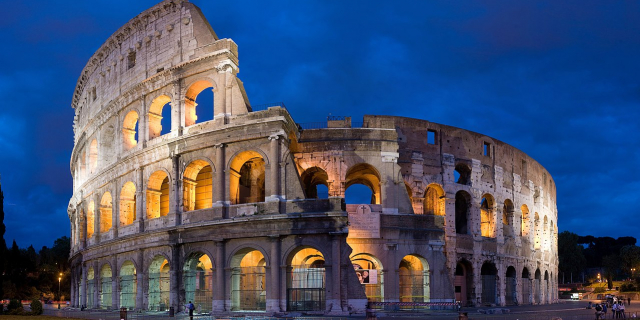Statua equestre di Marco Aurelio
( Equestrian Statue of Marcus Aurelius )
The Equestrian Statue of Marcus Aurelius (Italian: statua equestre di Marco Aurelio; Latin: Equus Marci Aurelii) is an ancient Roman equestrian statue on the Capitoline Hill, Rome, Italy. It is made of bronze and stands 4.24 m (13.9 ft) tall. Although the emperor is mounted, the sculpture otherwise exhibits many similarities to the standing statues of Augustus. The original is on display in the Capitoline Museums, while the sculpture now standing in the open air at the Piazza del Campidoglio is a replica made in 1981 when the original was taken down for restoration.
 The inscription on the plinth of the statue, commissioned by Pope Paul III
The inscription on the plinth of the statue, commissioned by Pope Paul IIIThe statue was erected around 175 AD. Its original location is debated: the Roman Forum and Piazza Colonna (where the Column of Marcus Aurelius stands) have been proposed.[1] However, it was noted that the site where it had originally stood had been converted into a vineyard during the early Middle Ages.[2]
Although there were many equestrian imperial statues, they rarely survived because it was the common practice to melt down bronze statues for reuse as material for coins or new sculptures in the late empire. Indeed, that of Marcus Aurelius is one of only two surviving bronze statues of a pre-Christian Roman emperor; the Regisole, destroyed after the French Revolution, may have been another. The equestrian statue of Marcus Aurelius in Rome owes its preservation on the Campidoglio to the popular mis-identification of Marcus Aurelius, the philosopher-emperor, with Constantine the Great, the Christian emperor; indeed, more than 20 other bronze equestrian statues of various emperors and generals had been melted down since the end of the Imperial Roman era.[3][4] It has been speculated that its misidentification stems from the prior existence of an equestrian statue of Constantine which had stood beside the Arch of Septimius Severus, and which had been most likely taken on the orders of the emperor Constans II during his visit to Rome in 663. With its removal, the people eventually mistakenly identified Marcus Aurelius's statue for Constantine's.[5]
In the Middle Ages this was one of the few Roman statues to remain on public view. In the 8th century it stood in the Campus Lateranensis, to the east of the Lateran Palace in Rome, sitting on a pedestal that was later provided by Pope Sixtus IV.[6] Its placement next to the Lateran Palace was due the fact that this site used to contain the house of Marcus Aurelius's grandfather Marcus Annius Verus, which was where the emperor's birth and early education took place.[2] By order of Pope Paul III, it was moved to the Piazza del Campidoglio (Capitoline Hill) during Michelangelo's redesign of the hill in 1538, to remove it from the main traffic of the square.[6] Though Michelangelo disagreed with the central positioning, he designed a pedestal for it.[1] The original bronze statue is in the Palazzo dei Conservatori of the Musei Capitolini; that in the square is a modern replica.
 The original statue in the Palazzo dei Conservatori
The original statue in the Palazzo dei ConservatoriOn the night of 29 November 1849, at the inception of the revolutionary Roman Republic, a mass procession set up the red–white–green tricolore (now the flag of Italy, then a new and highly "subversive" flag) in the hands of the mounted Marcus Aurelius.[7]
In 1979, a bomb attack in the nearby Palazzo Senatorio damaged the marble base of the statue.




























Add new comment